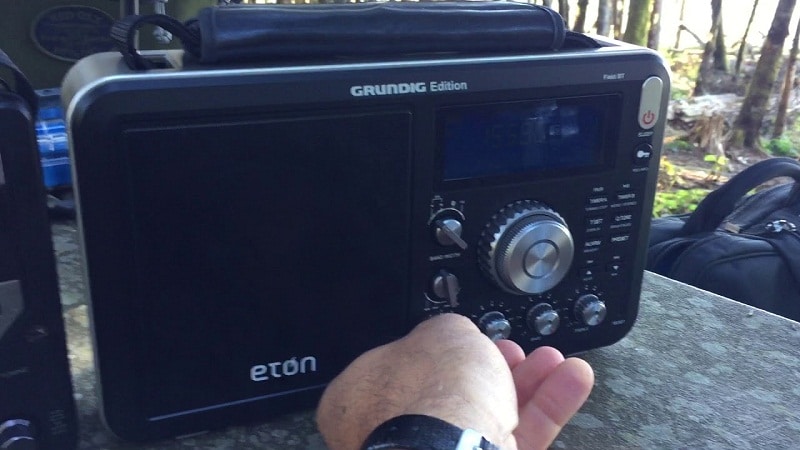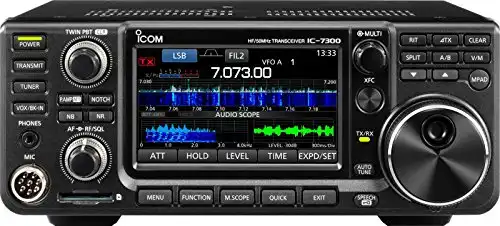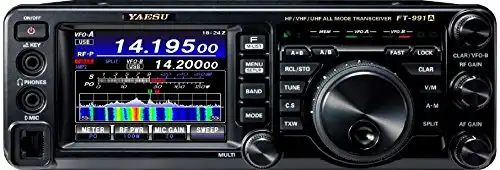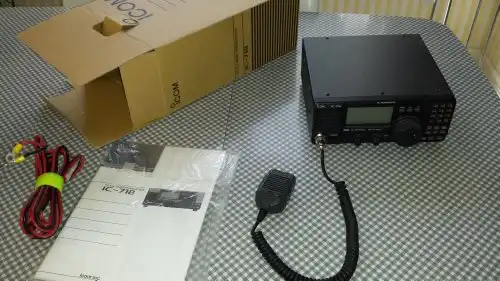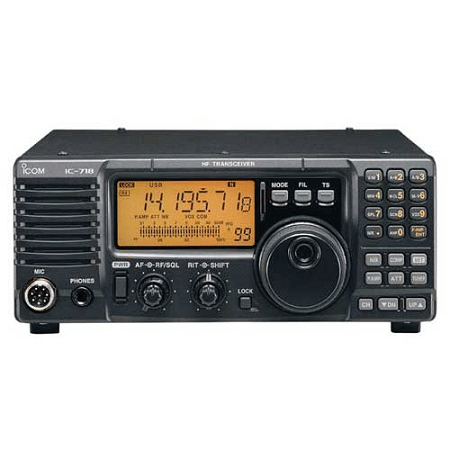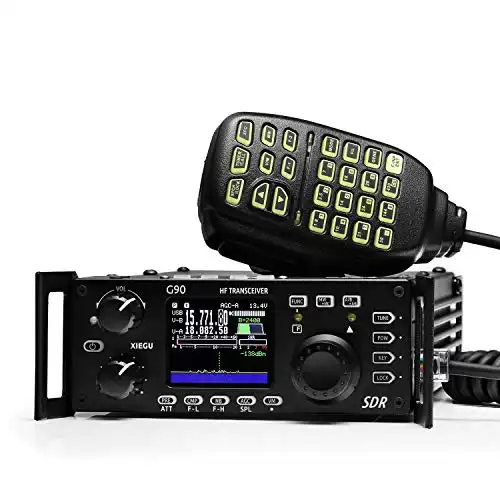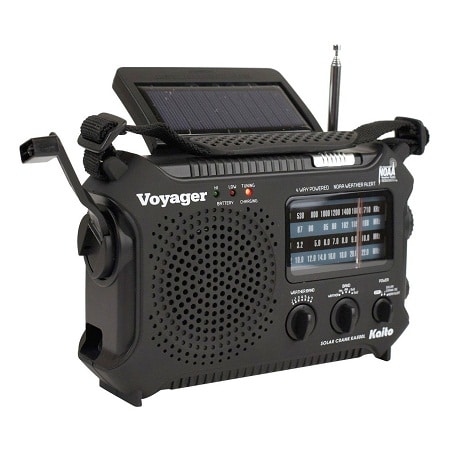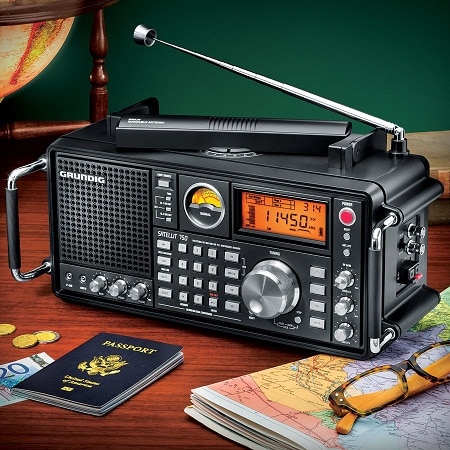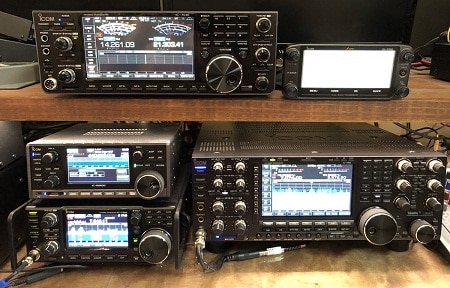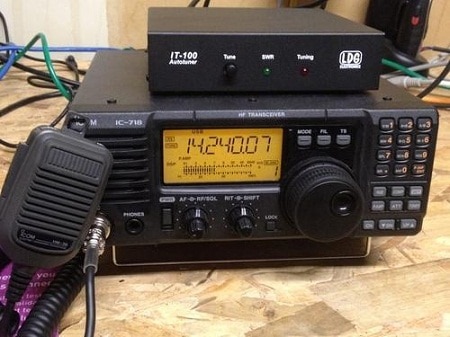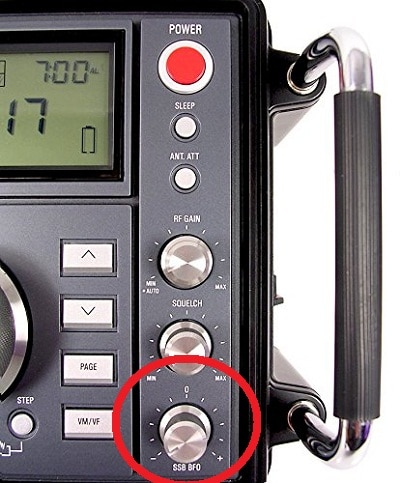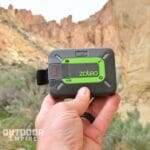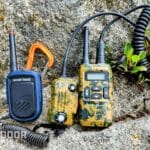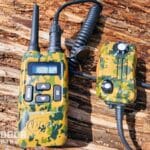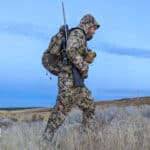Shortwave radios have certain advantages over other forms of radio communication, making them great for hobbyists and preppers.
The shortwave radio band, which is 3 to 30 MHz (or 10 to 100 meters), is actually pretty good at indirect communication.
Handheld radios basically need line-of-sight in order to talk to each other. UHF and VHF radios propagate better but are still limited in range.
High-frequency shortwave transmissions, on the other hand, can skip off the ionosphere for long-range propagation!
This lets you listen to radio broadcasts from across the nation. And if you have a transmitter or receiver and the appropriate amateur radio license, you can talk to people a surprising distance away.
The bad: Shortwave transmissions are power-intensive enough that you’re not going to be able to transmit with a handheld unit.
The ability to receive shortwave transmissions is still good for emergencies, though, and transceivers can fit in your vehicle too.
DISCLOSURE: As an Amazon Associate I earn from qualifying purchases. Links in this article are affiliate links. If you click on a link we may earn a commission if you make a purchase, at no additional cost to you.
The 8 Best Shortwave Radios: Outdoor Empire Reviews
- Best Overall Shortwave Radio Transceiver: ICOM 7300
- Most Versatile Stationary Shortwave Radio Transceiver: Yaesu FT-991A
- Best Entry-Level Shortwave Radio Transceiver: ICOM IC-718
- Best Vehicle Shortwave Radio Transceiver: Xiegu G90
- Best Overall Portable Shortwave Radio: Eton Grundig Satellit 750 Ultimate
- Best Emergency Shortwave Radio: Kaito KA500
- Best Compact Portable Shortwave Radio: C. Crane CC Skywave
- Best Budget Portable Shortwave Radio: Retekess V115
| Category | Best Overall Shortwave Radio Transceiver | Best Overall Portable | Best Vehicle |
|---|---|---|---|
| Product |  | 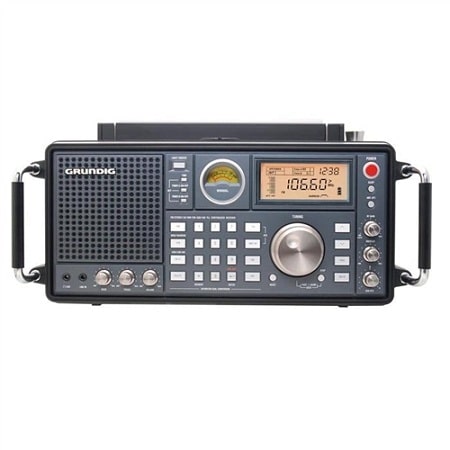 | 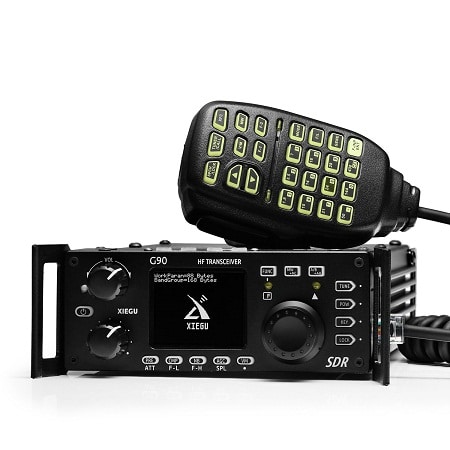 |
| Shortwave Frequencies | All | 1.711 MHz to 30 MHz | All |
| Bands | - MF - HF - limited VHF | - AM - FM - LW - SSB - Aircraft - Shortwave | - MF - HF |
| Transmission | Yes | No | Yes |
| Output Power | 100 watts | Yes | 20 watts |
| Weight | 9.26 lbs | 7.1 lbs | 2.2 lbs |
| Cost | Check Price | Check Price | Check Price |
1. Best Overall Shortwave Radio Transceiver
- Digital signal conversion minimizes noise
- Easy to use
- Great signal quality
- High amount of customization
- Waterfall display makes homing in on signals easy
- The antenna tuner isn't good for all antennas
- Expensive
Specs
- Shortwave Frequencies: All
- Bands: MF, HF, limited VHF
- Transmission? Yes
- Output Power: 100 watts
- External Antenna Capable? Yes
- Channels: 101
Overview
The ICOM 7300 is an expensive device that’s beloved by every radio operator who uses it. It’s capable of receiving all shortwave frequencies as well as medium frequencies and the six- and four-meter VHF bands.
It can transmit at frequencies from 1.80 MHz up to 54 MHz with a frequency resolution of 1 Hz. AM transmissions are limited to 25 watts of power while the other modes can use the full 100 for transmission.
AM, FM, CW, SSB, CW, and RTTY modes are available.
The 7300 uses an RF Direct Sampling System to reduce noise so you can hear fainter signals. Both a waterfall display and FFT spectrum scope make it easy to dial in exactly the frequency you desire. The intuitive touchscreen controls make this easy.
There’s a built-in antenna tuner, though you’ll need to add your own antenna. The 7300 also comes with an SD-card slot and a USB port.
Also, the ICOM 7300 is surprisingly easy to learn how to use!
Recommendation
The ICOM 7300 may be an expensive device, but it’s a capable and easy-to-use shortwave transceiver, though it has a limited range outside HF.
2. Most Versatile Stationary Shortwave Radio Transceiver
- Real-time spectrum scope and multi-color waterfall display
- Somewhat easy to use
- Works on the 160-to-6 meter, 2-meter, and 70-centimeter bands, including the newer 60-meter band
- Expensive
- Not quite as good reception as the ICOM 7300 (but by no means bad reception)
Specs
- Shortwave Frequencies: All
- Bands: MF, HF, VHF, UHF
- Transmission? Yes
- Output Power: 100 watts
- External Antenna Capable? Yes
- Channels: 100
Overview
The Yaesu FT-991A is the main competitor to the ICOM 7300 and wins in some ways but loses in others.
It has many of the same features as other models, but not quite as many, and some are not as well done. For example, the full-color touchscreen is smaller, making it less easy to use.
However, the FT-991A wins out on versatility. It can transmit in all amateur radio bands from 1.8 MHz to 430 MHz and can receive from 30 kHz to 470 MHz. It can receive AM, FM, CW, and SSB transmissions.
There’s also a built-in antenna tuner that’s a little bit more capable than the 7300s. The two antenna ports are HF/50 and 144/430.
It comes with a hand mic and an internal speaker, though the speaker’s audio quality is far less than what the transceiver is capable of putting out, so you’ll likely want to add an external speaker.
Recommendation
The Yaesu FT-991A is a more versatile shortwave radio transceiver than the ICOM 7300, though it’s not quite as easy to use and doesn’t quite have as good signal quality. It’s still good on both accounts, though!
3. Best Entry-Level Shortwave Radio Transceiver
- Good signal quality
- Minimal controls, so it won't overwhelm new learners
- Shortwave frequencies only
Specs
- Shortwave Frequencies: All
- Bands: MF, HF
- Transmission? Yes
- Output Power: 100 watts
- External Antenna Capable? Yes
- Channels: 101
Overview
Amateur shortwave radios can be expensive and complicated.
The ICOM IC-718 is a simple model that’s half the price of the ICOM 7300 or Yaesu FT-991A. It’s designed as an easy-to-use entry-level HF radio transceiver that’s not too complicated but is capable enough for you not to feel cheated when you get more skilled.
There’s no touchscreen or auto antenna tuner. However, excess controls and switches are minimized, so it’s easy to learn how to perform these tasks rather than using a shortcut.
The signal quality is good for the price when both receiving and transmitting. The front speaker is also nice enough that you won’t want to upgrade it immediately. It also comes with a basic but functional handheld microphone.
The biggest disadvantage of the IC-718 is that it’s an entry-level-focused transceiver but cannot be your first transceiver.
The starter amateur radio licenses do not allow for shortwave transmissions, so you have to have another transmitter unit already before you can get the license to use the IC-718.
Recommendation
The IC-718 is aimed at people new to shortwave transmission but is good enough to satisfy most HF radio enthusiasts.
4. Best Vehicle Shortwave Radio Transceiver
- Great audio quality
- Low power usage
- Prone to overheating
Specs
- Shortwave Frequencies: All
- Bands: MF, HF
- Transmission? Yes
- Output Power: 20 watts
- External Antenna Capable? Yes
- Channels: Not stated
Overview
The Xiegu G90 is an AM/FM/SW radio transceiver that’s optimal for use in your vehicle. Many of the other stationary radios can be installed in your car or truck, but they lack some of the features that make the Xiegu the better choice.
For one, the G90 is a QRP radio. “QRP” is Q code for “reduce power” and refers to how these radios try to maximize range and signal quality at lower power levels.
The G90 transmits at up to 20 watts in CW, FM, and SSB modes, and five watts in AM mode. It also draws only half an amp while receiving and only eight amps while transmitting.
It’s also a software-defined radio, which is a type of digital radio that’s more efficient than radio technology.
The LCD screen is full color and has a waterfall display, though it’s a bit cramped.
Finally, you can remove the display head and relocate it elsewhere in your vehicle! This allows you to place the actual transceiver in a better location. Put it someplace with good airflow, because the G90’s biggest weakness is overheating.
Recommendation
The Xiegu G90 is a great low-power shortwave radio that won’t drain your truck’s batteries dry, and it sounds great.
5. Best Overall Portable Shortwave Radio
- Great audio quality
- Receives more bands than most radios
- Rotating AM antenna
- Great audio quality
- Receives more bands than most radios
- Rotating AM antenna
Specs
- Shortwave Frequencies: 1.711 MHz to 30 MHz
- Bands: AM, FM, LW, SSB, Aircraft, Shortwave
- Transmission? No
- External Antenna Capable? Yes
- Memories: 1000
Overview
Once you get to battery-powered shortwave radios, you get into radios that can only receive. That’s fine if that’s what you want.
The Grundig Satellit is a classic series of shortwave radios, and the 750 Ultimate, made by Eton, is the current best version.
At 14.75 inches wide and weighing 7.1 pounds, the 750 Ultimate pushes the boundary of “portable.” It’s technically still a portable device and can take four D-cell batteries if you want to take it wireless.
It has two antennas. One rotates in a circle for AM reception, and the other extends upward. You can plug in antennas to increase your reception too.
The 750 Ultimate specializes in receiving shortwave transmissions and can receive the VHF airplane band as well, making it more than an AM/FM/SW radio.
The Satellit 750’s audio quality is typically excellent. However, some people have a hard time finding a good choice between the wide AM filter and the narrow AM filter.
Recommendation
The Grundig Satellit 750 Ultimate is an excellent radio for receiving shortwave broadcasts and monitoring aircraft and maritime traffic, but it’s a hefty device.
6. Best Emergency Shortwave Radio
- Can charge your smartphone enough for an emergency call
- Multiple power sources independent of the power grid
- NOAA weather alerts
- Doesn't receive all shortwave bands
- Has to be tuned manually
- Wall power adapter is sold separately
Specs
- Shortwave Frequencies: 3.2 MHz to 22 MHz
- Bands: AM, FM, Shortwave, NOAA Weather
- Transmission? No
- External Antenna Capable? Yes
- Memories: None
Overview
When disaster strikes, you may not be able to run that desk shortwave radio unit because the power is out. How, then, will you listen to potentially important radio broadcasts?
Emergency weather radios are designed to alert you of hazardous weather situations and to survive without external power, but few can receive shortwave transmissions.
The Kaito KA500 is a good emergency weather radio that has two-band shortwave capabilities.
It can receive shortwave broadcasts from 3.2 MHz to 10 MHz on one setting and from 10 MHz to 22 MHzs on another setting. It misses out on the 12- and 10-meter bands, though.
Other features include a solar panel, hand crank to generate power by hand, rechargeable batteries, and the ability to take three AA batteries. There’s even a USB port so you can charge mobile devices!
It also has an LED flashlight and an LED reading lamp, plus a red LED that can serve as an SOS beacon.
KA500’s body is both impact and water resistant, so it’ll survive outdoor recreation.
Recommendation
The Kaito KA500 is one of the rare emergency weather radios that can listen in on shortwave bands, though it’s not the best at either aspect.
9 Best Emergency Radios Reviewed ( Battery & Hand-Crank Survival Radios )
7. Best Compact Portable Shortwave Radio
- Great audio quality
- Has many features for its small size
- Long battery life
- Expensive
Specs
- Shortwave Frequencies: 1.711 MHz to 29.99 MHz
- Bands: AM, FM, SW, SSB, NOAA Weather, VHF Aviation
- Transmission? No
- External Antenna Capable? Yes
- Memories: 400
Overview
Crane is known for making great radios, and the Skywave is no exception.
The Skywave is a compact radio about the size of your hand and can receive shortwave signals when you plug in the 23-inch antenna that comes in the package. Not only can it receive all of the shortwave band, but it’s also an SSB radio and can even listen to the aviation traffic VHF band.
It has a digital display that can store 400 channels, scan 10 aviation channels, and be used as an alarm clock. The back folds down into a stand so the unit won’t fall over.
The built-in antenna is long for the radio’s size and receives quite well. The audio quality of the Skywave is great, and even the included headphones are above average.
Two AA batteries will keep the Skywave listening for up to 60 hours, though you can also buy a wall power adapter to plug in the device. Don’t use a normal cell phone power adapter, even if it fits, because those will cause RF noise that degrades the audio quality.
Recommendation
The C. Crane CC Skywave is an excellent compact and lightweight radio with shortwave capabilities and great reception, though it’s a bit on the expensive side.
Learn more about the C. Crane CC Skywave.
8. Best Budget Portable Shortwave Radio
- 3.5 millimeter AUX input
- Compact and lightweight
- Good volume
- Limited shortwave frequencies
- No external antenna jack to enhance shortwave reception
Specs
- Shortwave Frequencies: 4.75 MHz to 21.85 MHz
- Bands: AM, FM, Shortwave
- Transmission? No
- External Antenna Capable? No
- Memories: 99
Overview
Shortwave radios are more expensive than most other radios, but the Retekess V115 shows they don’t have to be.
This small radio can receive AM, FM, and most shortwave bands. It’s range of 4.75 MHz to 21.85 MHz covers much what’s broadcasted, but not the farthest-ranging 12- and 10-meter bands. Also, you cannot plug in an external antenna, so the V115 doesn’t have the best shortwave reception.
Still, for half the price of the next cheapest product, even having SW is a good value.
The V115 also has an AUX-in port so you can use it as an external speaker. It has pretty good audio quality, though it won’t win any awards. There’s also a microphone you can use to record onto an SD card.
The 1,000 mAh lithium-ion battery is built-in and charges using the included USB cord. It’ll last for several days straight of playing, though it’s a cell phone battery instead of a standard battery, so replacements can be difficult to find.
Recommendation
The Retekess V115 is an inexpensive pocket radio that can listen to shortwave and provides a lot of value for your dollar.
What Is a Shortwave Radio?
The word “shortwave” refers to radio frequencies in the high frequency (HF) band. This is from 3 MHz to 30 MHz, also known as 100 meters to 10 meters.
Shortwave radios were some of the earliest radios used for long-range communication. Though it’s not as widely used any more, shortwave still has some advantages over traditional AM and FM radios and is still used in certain situations.
Here are some modern shortwave applications:
- International broadcasts to communicate news or propaganda to citizens of other countries
- Time signals to keep certain clocks tuned to the correct time
- Long-distance utility broadcasts for maritime operations and air traffic control
- Pirate radio
- Illegal communication by rebel groups
- Clandestine communication between spies and their spy agency
- Broadcasts to people living in rural areas
- Emergency communications
- Amateur radio
How Does a Shortwave Radio Work?
Shortwave radio requires long antennas and plenty of power to broadcast. However, the radio waves are capable of immense ranges and can even be heard over the horizon (with the appropriate atmospheric conditions).
There’s a layer of electrically charged atoms floating high above you. It’s called the ionosphere.
If you aim a shortwave radio transmission at the ionosphere, the wave will bounce off this layer of the atmosphere toward the ground, quite far away. This is called either skywave or skip propagation.
This strength is also a weakness, because these waves are susceptible to interference.
Everything from the sun to a nearby LED light can disrupt shortwave radio reception.
Non-radio-savvy reviewers will often complain about poor shortwave reception despite being in a building surrounded by electric devices that all disrupt the incoming short waves!
Why Is It Important to Choose a Quality Shortwave Radio?
Since shortwaves are so commonly disrupted, it’s important to have the highest-quality shortwave receiver possible to maximize your chances of getting a good signal.
If you have a low-quality shortwave radio, then you might as well not even have a shortwave radio. You’ll have a hard time receiving broadcasts.
And if you need to listen to shortwave radio transmissions because there’s no other method of communication within range, well, that just won’t do.
Shortwave Radio Buying Advice
Shortwave radios can be put into two categories: transceivers and receivers.
Radio transceivers can receive and transmit radio waves.
Receivers, on the other hand, can only receive.
Radio transmission requires power and an antenna. Shortwave radios require a lot of power (though not as much as an FM radio) and a long antenna.
This means the closest thing you’ll get to a portable shortwave transceiver is one you can mount to your vehicle.
Therefore, the questions “desktop or portable?” and “transceiver or receiver?” have the same answer.
Desktop or Portable

Do you want to listen to shortwave broadcasts, or do you want to be able to transmit your own as well?
Shortwave radio receivers can be as small as your hand, though you’ll want a bigger unit if you want better reception.
Shortwave transmission, on the other hand, requires a large antenna and a connected power supply so the station can draw multiple amps of power and output 5, 20, or even 100 watts into the HF waves.
Portable shortwave receivers are good for listening and nothing more.
You can listen to broadcasts from other nations, which is good for hobbyists. Hikers, hunters, preppers, and other folks can listen to news and warnings over shortwave when out of range of AM and FM radio towers or when surrounded by mountains that block those broadcasts.
If you want to transmit, you’ll need a stationary shortwave radio, a long antenna, and a power source.

You’ll also need a ham radio license. The Technician class won’t cut it; you’ll need a General class license or Amateur Extra License. These take time and money to receive.
However, a stationary transceiver can receive without transmitting. Also, the FCC may forgive you for transmitting without a license during a life-or-death situation.
Therefore, it may still be beneficial to buy a transceiver instead of a receiver even if you only want to listen.
Other Bands
Shortwave radio covers only the HF bands and doesn’t have the best audio fidelity.
Many, but not all, shortwave radios can transmit or receive on more bands than just the SW bands. This broadens your communication capabilities greatly.
I would recommend getting a more versatile shortwave radio over one that just has shortwave capabilities, unless you already have a ham radio that covers the other bands.
Shortwave radios are less common than VHF/UHF radios, so it’s entirely possible for amateur radio enthusiasts to take advantage of a shortwave-only radio.
That way you can communicate over the horizon without depending on a repeater!
SSB
SSB means “single-sideband modulation.”
It’s a method of transmitting audio over radio that’s more efficient than AM. It takes half as much bandwidth to broadcast an SSB signal compared with an AM signal, so you can achieve greater audio fidelity while consuming less power.
However, this type of modulation is more complicated for the receiver. This means fewer receivers can convert SSB signals to voice.
If possible, choose a radio with SSB over one without. It improves your communication options. After all, isn’t that the point of getting a shortwave radio in the first place?

